#countess of albany
Explore tagged Tumblr posts
Text

An engraving of Louise of Stolberg-Gedern, Countess of Albany. She was the wife of Charles Edward Stuart, popularly referred to as "Bonnie Prince Charlie".
#Louise of Stolberg-Gedern#countess of albany#charles edward stuart#bonnie prince charlie#jacobites#18th century#long live the queue
18 notes
·
View notes
Text
➳ Happy mother's day! 💐🩷
Here is my favourite picture of Princess Alice of Albany & Prince Charles Edward of Albany with their mother, Princess Helen, Duchess of Albany! 🥰

Part 6 out of 6!
#princess alice of albany#princess alice countess of athlone#prince charles edward of albany#princess helen duchess of albany#princess helen of waldeck and pyromnt#british royal family#mother's day
5 notes
·
View notes
Photo
She's so pretty! 🥺🤍💗

Princess Alexander of Teck (after 1917 Princess Alice, Countess of Athlone), 1911
92 notes
·
View notes
Text
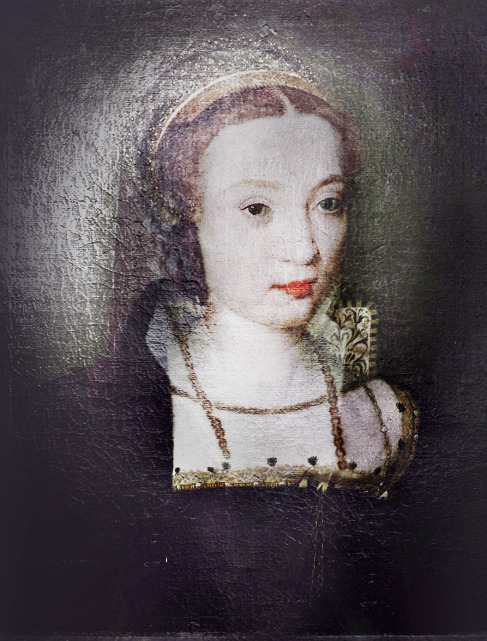

On July 17th 1537 Janet, Countess of Glamis was burnt at the stake on Edinburgh's Castlehill after being found guilty of two counts of treason.
Lady Glamis was the sister of Archibald Douglas, sixth Earl of Angus, who became the second husband of the Scottish Queen Dowager, Margaret Tudor, in 1514.
After James IV, had been killed at the battle of Flodden in 1513 his mother Margaret subsequently ruled Scotland as regent. She remarried and the ole of her new husband, the Earl of Angus, caused resentment among the Scottish nobility so much so John Stewart, Duke of Albany, was proclaimed replacement regent in 1517.
The on-going feuds between the Stewart and Douglas clans would heavily influence James V, who came of age in 1528 and sought to assert his influence on his kingdom. He was brieflyheld aptive by Angus as a young child in his attemptto control the country, thisis said to have deeply affected the young King.
His anger and desire for revenge later became centred on Janet Douglas. When her husband died, she was left without a protector.
James V accused her of poisoning her first husband, John Lyon, sixth Lord Glamis, when he died in 1528. She was however acquitted and remarried Archibald Campbell in 1532, after ceasing all communication with the Douglas clan in order to try and prove her innocence to James V.
This peace was not long lasting and five years later James once again accused her of attempting to poison him and also of conspiring with the Douglas clan against him.
These accusations of treason and witchcraft were ungrounded. To combat the lack of proof for these heavy claims, James managed to gather evidence against Lady Janet by torturing her family and servants to the point of extracting false evidence and statements against her nature. It is said that her young son was forced to watch his servants and family being tortured, before being tortured himself on the rack.
The rack was an implement of torture and was used to ‘stretch’ victims to the point of excruciating pain by tying their ankles and wrists separately and pulling them in opposite directions.
Lady Janet was subsequently burned at the stake at Edinburgh Castle, where allegedly her son was forced to watch her burn before he was released. It is said the onlookers watched in silence, tears in their eyes.
Lady Janet is said to roam the halls of Glamis Castle… she has been seen wandering the halls, kneeling in front of the alter praying in the chapel and above the clock tower.
Apparently, when in the chapel of the castle, people are overcome with a feeling of immense sadness and desolation. A seat is constantly kept empty for Lady Janet in the chapel, and it is said one hundred witnesses once saw her glide past them in the chapel, heading towards her allocated seat.
Lady Janet Douglas of Glamis is remembered as one of the most tragic figures in our history.
33 notes
·
View notes
Text
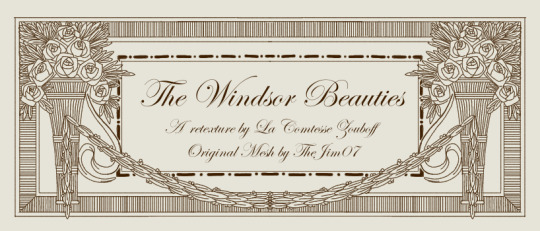

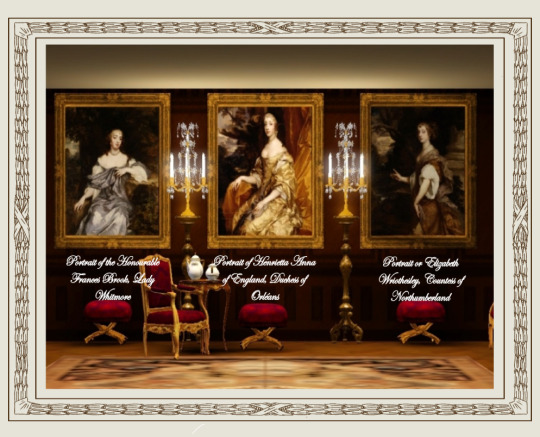
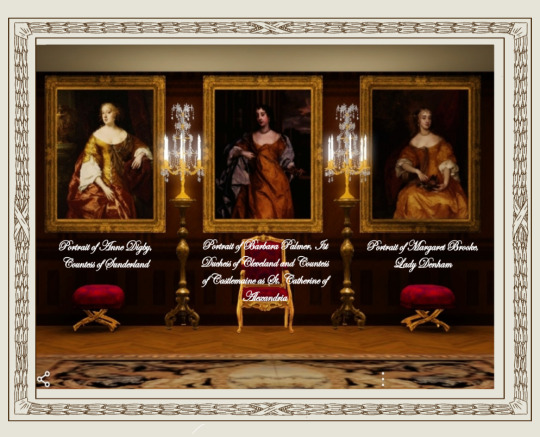
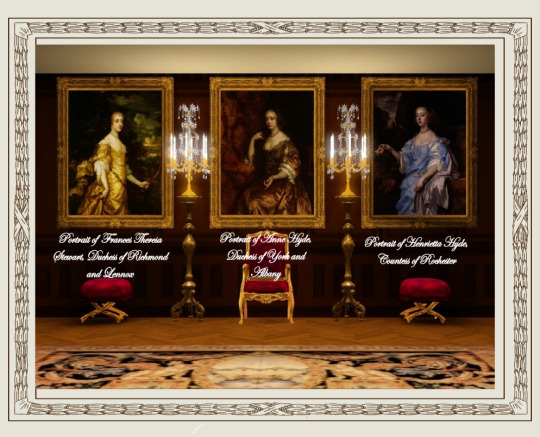

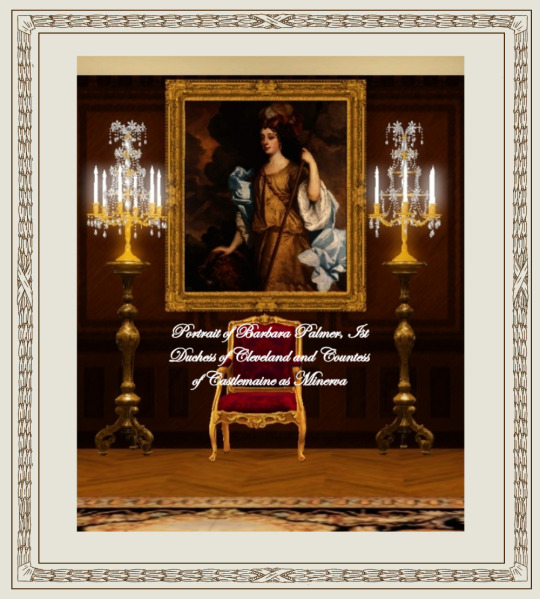
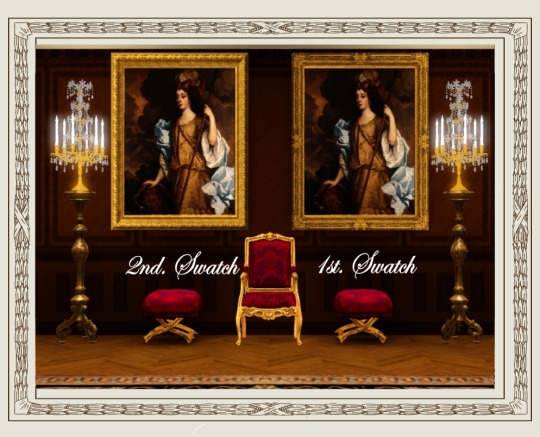
The Windsor Beauties Set
A retexture by La Comtesse Zouboff — Original Mesh by @thejim07
The Windsor Beauties are a set of portrait paintings, still in the Royal Collection, by Sir Peter Lely and his workshop, produced in the early to mid-1660s, that depict ladies of the court of King Charles II, some of whom were his mistresses. The name stems from the location of the collection, which was at Windsor Castle.
Originally commissioned by Anne Hyde, Duchess of York, the first mention of the paintings is by Samuel Pepys, describing them in his diary as being hung in "the Duke of York's room" in 1668. A 1674 inventory lists them as in the ducal rooms at St. James Palace and by 1688 they had moved to the "Princess's dressing room" at Windsor Castle. Moved to the castle's state rooms during the 18th century, the Windsor Beauties were transferred to Hampton Court at some time prior to 1835.
They are considered the pinnacle of restoration art and are regarded as one of Lely's most exquisite work.
The set includes 13 portraits, with the original frame swatches, fully recolorable. The portraits are of:
Anne Digby, Countess of Sunderland
Anne Hyde, Duchess of York and Albany
Barbara Palmer, Ist Duchess of Cleveland and Countess of Castlemaine as Minerva
Barbara Palmer, Ist Duchess of Cleveland and Countess of Castlemaine as St. Catherine of Alexandria.
Elizabeth Bagot, Countess of Falmouth
Elizabeth Hamilton, Countess de Gramont as Saint Catherine
Elizabeth Wriothesley, Countess of Northumberland
Frances Theresa Stewart, duchess of Richmond and Lennox
Henrietta Anne of England, Duchess of Orléans
Henrietta Hyde, Countess of Rochester
Jane Needham, Lady Middleton
Margaret Brooke, Lady Denham
The Honourable Frances Brook, Lady Whitmore
Found under Decor > Paintings for 1.650 §
Retextured from "Portrait of Cardinal de Mazarin" found here
Chairs, stools, side table and bronze "Pendule á Cercles Tournants" by @joojconverts
Walls, floor, torchere, girandole and table by @thejim07
Tea pot, milk jugar, sugar bowl and teacup by @aroundthesims
White vase by @martassimsbookcc
Rug by me (to be released)

(Drive)
(Sims3pack and Package)
(Useful tags below)
@joojconverts @ts3history @ts3historicalccfinds @deniisu-sims @katsujiiccfinds
-------------------------------------------------------
#the sims 3#ts3#sims 3 cc#sims 3#s3cc#sims 3 download#portrait#sims 3 paintings#retextures#La Comtesse Zouboff#baroque#englishbaroque#windsor castle#windsor beauties#sir peter lelly#sims 3 decor#historical cc find#sims 3 art#wall decor
68 notes
·
View notes
Text
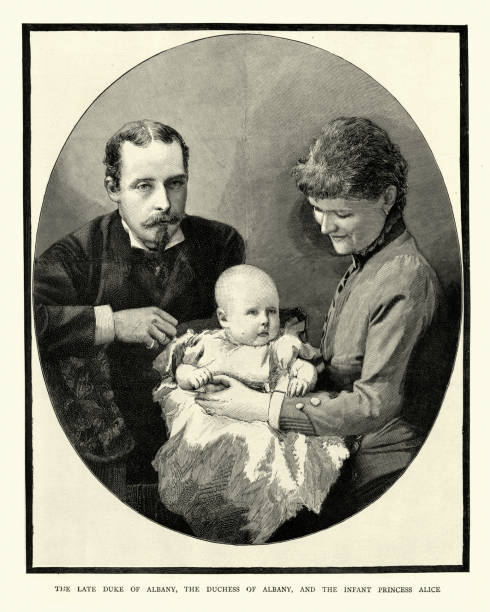
Vintage engraving of Prince Leopold, Duke of Albany with wife, Princess Helen of Waldeck and Pyrmont, and daughter, Princess Alice (Countess of Athlone). ☺
16 notes
·
View notes
Video
Love her!! 😭❤
youtube
HRH Princess Alice Mary Victoria Augusta Paulina of Albany, Countess of Athlone, VA GCVO GBE GCStJ
Died January 3, 1981 - the longest-lived British Princess of the Blood and last living grandchild of Queen Victoria.
10 notes
·
View notes
Photo

Anton Raphael Mengs (German, 1728–1779) Parnassus, after 1761 Hermitage Museum This painting represents a sketch or a replica, produced by the author himself, of the central part of the ceiling in the main hall of the Villa Albani in Rome. The plafond created by Mengs in the fresco technique, in 1761, was commissioned by Cardinal Alessandro Albani. In this painting Mengs broke away from Baroque tradition and turned to the conventions of Neoclassical art. The general composition is inspired by Raphael’s fresco ‘Parnas’ in Stanza della Segnatura in the Vatican Palace in Rome. In the centre is Apollo Mousagetes, the Sun God, patron of the arts and the leader of the Muses, with his attributes of a lyre, a crown on the head and a laurel wreath in his hand. Seated to his right is Mnemosyne, the mother of the Muses and the goddess of memory, as well as Clio, the Muse of history, Thalia, the Muse of comedy, and the dancing Erato and Terpsichore. To his left is Calliope, Polyhymnia, Euterpe, Melpomene and Urania. The painter depicts the Muses with their attributes. Clio’s features bear a close resemblance to those of Mengs's wife Margarita, while Mnemosyne has a likeness to Vittorucchia, the daughter of Countess Ceroffini.
#Anton Raphael Mengs#German art#germany#european art#mediterranean#classical art#art#traditional art#oil painting#1700s#europe#greek mythology#cradle of civilization
35 notes
·
View notes
Text
Queen Victoria's Currently living Eldest Decendants and Eldest Ever Descendants
This list is as of 19 April 2024
CURRENTLY LIVING
The Lady Pamela Hicks (19 April 1929) (95 years, 0 months, 0 days)
Princess Astrid, Mrs. Ferner (12 February 1932) (92 years, 2 months, 7 days)
Count Bertram Friedrich zu Castell-Rüdenhausen (12 July 1932) (91 years, 9 months, 7 days)
Mrs. Anne Mary Sibylla Liddell-Grainger (28 July 1932) (91 years,8 months, 22 days)
Princess Caroline Mathilde Adelheid Sibylla Marianne Erika von Sachsen-Coburg und Gotha (5 April 1933) (91 years, 0 months, 14 days)
Princess Dorothea Charlotte Karin of Hesse (24 July 1934) (89 years, 8 months, 26 days)
Princess Margaretha Désirée Victoria, Mrs. Ambler (Sweden, 31 October 1934) ( 89 years, 5months, 13 days)
Countess Viktoria Adelheid Clementine Louise von Castell-Rüdenhausen-Von Huntington-Whiteley (26 Februrary 1935)(89 years, 1 months, 24 days)
Prince Edward George Nicholas Paul Patrick, The Duke of Kent (9 October 1935) (88 years, 6 months, 10 days)
Miss Elizabeth Alice Abel Smith (5 September 1936) (87 years, 7 months, 14 days)
Eldest LIVED Descendants:
On 12 June 2025, Princess Astrid, Mrs. Ferner will join this list if she is still living.
Prince Philip, The Duke of Edinburgh (10 June 1921-9 April 2021) ( 99 years, 10 months, 11 days)
Princess Alice of Albany, Countess of Athlone (25/02/1883-03/01/1981) (97 years, 10 months, 10 days)
Queen Elizabeth II of The United Kingdom (21 April 1926-8 September 2022) ( 96 years, 4 months, 18 days)
King Mihai I of Romania (25/10/1921-05/12/2017) ( 96 years, 1 month, 11 days)
Count Carl Johan Bernadotte af Wisborg (Sweden) (31/10/1916-05/05/2012) (95 years, 6 months, 5 days )
The Lady Pamela Hicks (19 April 1929) (95 years, 0 months, 0 days)
Count Sigvard Bernadotte af Wisborg (of Sweden) (07/06/1907-04/02/2002) (94 years, 7 months, 28 days )
Lady Katherine Brandram (Princess of Greece and Denmark) (04/05/1913 02/10/2007) ( 94 years, 4 months, 27 days )
Infanta Dona Beatriz Isabel Federica Alfonsa Eugénie Cristina Maria Teresia Bienvenida Ladislàa of Spain, The Princess of Civitella-Cesi (22/06/1909-22/11/2002) (93 years, 5 months, 1 day)
Patricia Edwina Victoria Mountbatten- Knatchbull , The 2nd Countess Mountbatten of Burma (14/02/1924-13/06/2017) ( 93 years, 4 months)
FACTS:
The Duke of Edinburgh is the husband and third cousin of Queen Elizabeth II, first cousin of Lady Katherine Brandram, The Countess Mountbatten of Burma & Lady Pamela (Mountbatten) Hicks & uncle to Princess Dorothea Charlotte Karin of Hesse. He is also a 1st cousin 1x removed of Queen Sofia of Spain, King Constantine II of the Helenes and Princess Irene of Greece & Denmark and The Duke of Kent (The Duke of Kent’s mother Marina was The Duke of Edinburgh’s first cousin).
Queen Elizabeth II is a 3rd cousin of The Countess Mountbatten of Burma, Lady Pamela Mountbatten, The Duke of Edinburgh. She is the wife of The Duke of Edinburgh. Through her marriage, she is an aunt to Princess Dorothea Charlotte Karin of Hesse. She is a first cousin of The Duke of Kent.
Lady Pamela Hicks is a 3rd cousin of Queen Elizabeth II, a first cousin of The Duke of Edinburgh, her big sister was The Countess Mountbatten of Burma.
Princess Astrid, Mrs. Ferner is a third cousin of The Countess Mountbatten of Burma, The Duke of Edinburgh, Queen Elizabeth II & Lady Pamela Hicks.
The Countess of Althorne was the last surviving grandchild of Queen Victoria. By her marriage, The Countess of Althorne was also a great aunt of Queen Elizabeth II-she married QEII’s grandmother’s brother
King Mihai I of Romania was the last monarch of Romania, he was also a great grandchild of Queen Victoria twice-once through his mother (via Victoria, Princess Royal) and once through his father (via Alfred, Duke of Saxe-Coburg and Gotha)
Sweden’s Count Carl Johan Bernadotte af Wisborg & Count Sigvard Bernadotte af Wisborg were brothers as well as uncles to King Carl XVI Gustaf, Princess Margareta, Mrs. Ambler, Princess Birgitta of Sweden, Princess of Hohenzollern, Princess Désirée, Baroness Silfverschiöld, Princess Christina, Mrs. Magnuson, Queen Margrethe II of Denmark, Princess Benedikte of Sayn-Wittgenstein-Berleburg & Queen Anne-Marie of Greece.
Countess Viktoria Adelheid Clementine Louise von Castell-Rüdenhausen-Von Huntington-Whiteley was a great granddaughter of Prince Leopold, The Duke of Albany, thus a great great granddaughter of Queen Victoria. She is also the younger sister of Count Bertram Friedrich zu Castell-Rüdenhausen.
#Queen Victoria#Queen Victoria's Descendants#British Royals#Greek Royals#Mountbatten Royals#German Royals#Swedish Royals
4 notes
·
View notes
Text
Wedding of The Princess Imperial and Viscount Bridger: Foreign Royals Arrive
Foreign Royals from all over the sim continent have begun to arrive at St. Peter's Abbey.

The first of the foreign royals to arrive are Their Royal Highness' The Duke and Duchess of Lockwood. Her Royal Highness looks lovely in a dark blue lace dress and matching fascinator. This is TRH first visit to Caledonya and TIM hope to continue a friendship with Albany. @albanyroyals

The next to arrive are Their Royal Highness' The Crown Prince and Princess of Esha. Her Royal Highness dazzled in a green dress and matching fascinator. This is Their Royal Highness' first visit to Caledonya and we certainly hope it won't be the last. @crownsofesha

Following The Crown Princely couple are Their Royal Highness' The Duke and Duchess of Laye. Duchess Vivienne wore a lovely purple dress with a white fascinator with dark blue accents. This is again TRH first visit and TIM hope to further relationships with Armorica. @armoricaroyalty

Next to arrive is Their Royal Highness The Countess of Chafford and The Viscountess of Bellavista. The Countess looks gorgeous is a dark purple dress and The Viscountess sparkled in a dark green dress. Another new royal visitor to the Empire. TIM hope again to continue friendships with Kindelria. @houseoflennoxx

Next to arrive from Eltonia are Their Majesty's King Frederick and Queen Elenore. Queen Elenore looked gorgeous in a dark blue silk dress and fascinator. TM are friends and ally's of the Empire.@miyuzarry

Last of the foreign royals to arrive and distant cousins of the bride are Their Imperial Majesties The Emperor and Empress of Alexandria. Empress Regina dazzled in a light blue dress with a matching fascinator. @thealexandrianroyals
#sims 4 royal family#sims 4 royal legacy#the sims 4 monarchy#sims 4 simblr#sims 4#the sims 4#stthomaspalace#the sims 4 imperial wedding#chapter1
34 notes
·
View notes
Text

Tiara Alert!
- The Royal Collections
The coronation of King Luca and Queen Noelle has come and gone. And as you know, we at the royal collections always appear! We got to see a lot of an amazing ladies and wonderful crown's and tiara's! Now, let's take a look at the amazing display!
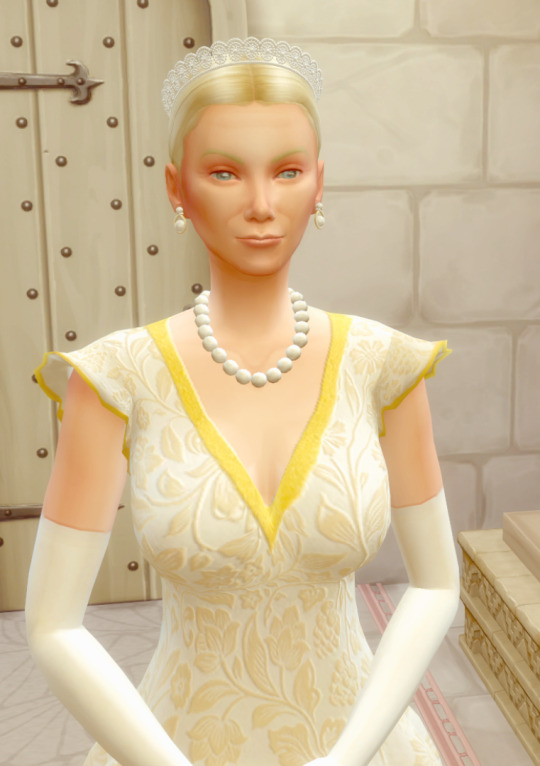
First up, we have the newly minted Duchess of Delany. The Duchess is wearing the Daisey Circle tiara. This tiara is one of the few tiara's owned by the Taylor family. It also is a somewhat new addition, a personal gift to Elizabeth Taylor from her husband Henry Taylor. He had the tiara designed after Elizabeth's favorite flower. He gifted it to her on their 10th wedding anniversary. The tiara had been fitted with diamond's and pearls that shows it's simple elegance and it's benefiting of her new station.

Now, Roa, Duchess of Whitlock has graced us with the San Sequoia State Crown. This crown first made it's appearance at the coronation of King XXXX and Queen XXXX. King XXXX had two possible crown's made for his wife for the coronation. Queen XXXX was said to have picked this because she felt like it suited her best. This was the first crown commissioned by the Sorensen family. Thus, it was given it's title. This crown could be called be called Roa's staple. During her time as Queen she favored this crown during state events. It's no surprises that she also wore it for this event! It could be seen as a sign of trust Queen Noelle has become the most recent royal woman to wear this crown. Shortly before our post went up, the palace released more official photos from the coronation! We're always glad to see this gem and Roa looked wonderful today!
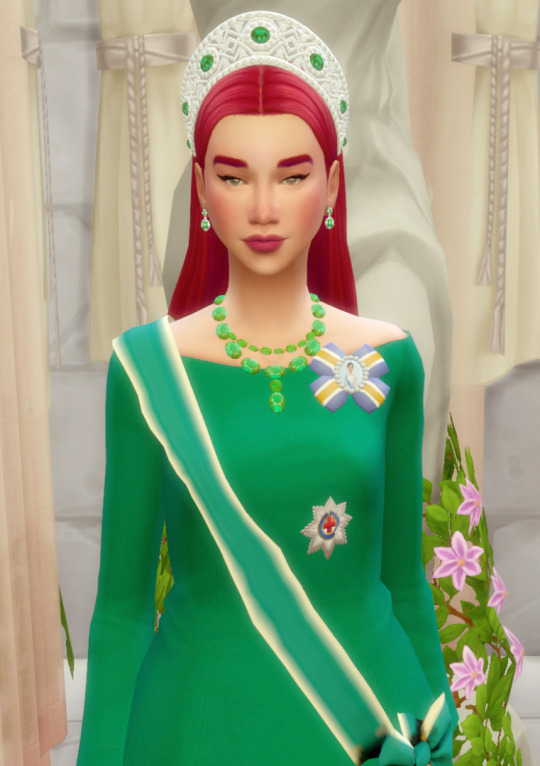
The Princess Royale looked lovely at the coronation. As a representative of Windenburg, we can say she did a wonderful job! She is wearing the Albany Diadem. The tiara was personally bought by the 3rd Duchess Albany, Maple, also known as Grand Duchess in 1807. The Duchess was the second wife to King Duke the 2nd. When she passed, the tiara was left in the collections of the Royal Family as her only daughter, Princess Beatrice had been married off into the Oasis Springs royal family. Since then, it's been staple part of royal watching. The diadem with a large arch and emerald settings was last worn by Julia, Princess Royale at the coronation of King Luca and Queen Noelle. The diadem with a large arch and emerald settings was last worn by Queen Noelle when she married King Luca.

The Duchess of Cove has always managed to subtly shine in the moment. For the coronation, she chose to wear the Windflower Crystal Tiara. It was Commissioned by King XXXX in XXXX. It appeared shortly after Windenburg split but it has been rarely worn due to it's delicate nature, it's normally on display in XXXX castle.
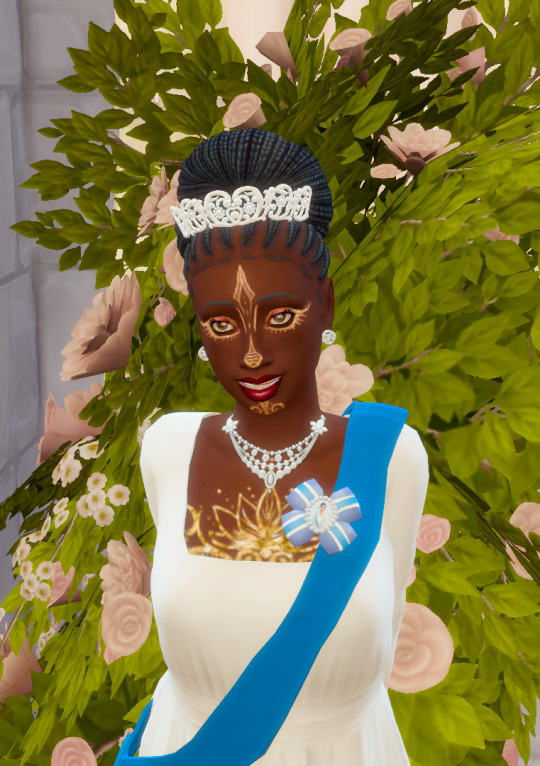
Next we have Queen Najwa in the Window's Heart tiara. It was brought from jeweler Hermes & Co between 1997 and 1998 by a member of the royal family and made it's debut on the head of Crown Princess at her first event hosted in Glimmerbrook in 1999. The crown is made out of ivory and pearls, it's name only only comes from the heart that is depicted but the openness of it.

Here we have Anna, Baroness of York. Today, she debuted the Butterfly Bow tiara. This was another tiara owned by the first Duchess of Albany, but not as beloved. It was gifted to her but her aunt who was the then Princess Amelia of Willow Creek. The tiara holds three large diamonds in the center of three bow's that look like butterfly's. While she only wore it a few times, it was said to be treasured by her and it was left to her niece along with other items in her personal collection. Though, it does not have the history of fighting over it as some other pieces due. While it was dear to the duchess, it wasn't very sought after. Since then, it has remained in the Taylor family.
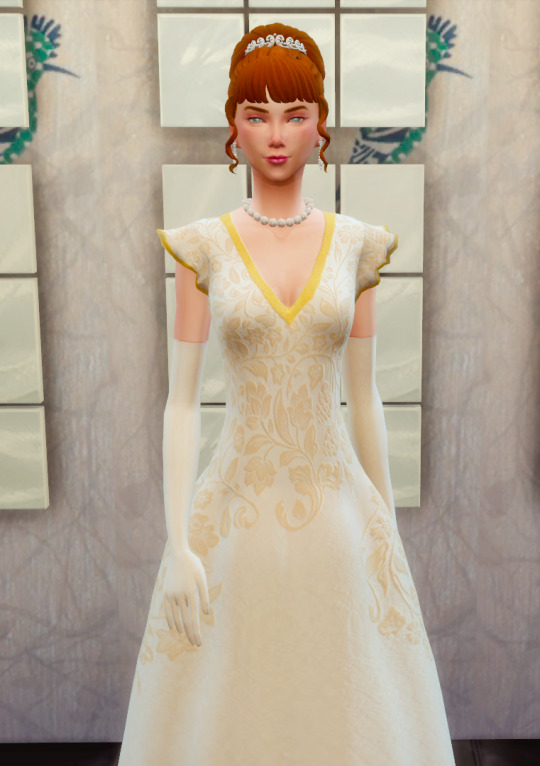
Layla Taylor, Countess of Inverness also made her mark at the Coronation. Today, the Angel Wing tiara was brought out of the vault. It's one of the oldest tiara's that's come across Windenburg's royal history. The tiara belonged to the first Duchess of Albany, the second wife of King Oslen. Her family though not of the nobility they were one of the wealthiest. The Duchess was married into the family due to their need to secure themselves and gain a solid foot-hold as the Kingdom started to form. During this time, the Duchess had her tiara created to be the image of angel wings represented by waves, centered by a diamond in the middle. The tiara was also highly desired by the King's main wife and it was assumed that it would go to the royal family when she passed. That was not the case, it was made clear that it was privately owned and she left the tiara to her niece. Since then, it has remained in the Taylor family and is not often seen. We're happy that we could see such a piece today!

Crown Princess Marie looked stunning at the coronation! She gifted us with a look at the The Great Curled Pearl Tiara. This tiara was brought from a local jeweler in Queen's Bianca's hometown. Her husband, then King Matteo the 2nd gifted it to her. He had selected a piece from there due to her love of her hometown. The main point of the design being the waves which represent the great waters around the country. Along with it being adorned by small pearls and diamonds. Later on the king had smaller version of the tiara made for his daughter's 18th's birthday called the Curled Pearl tiara.
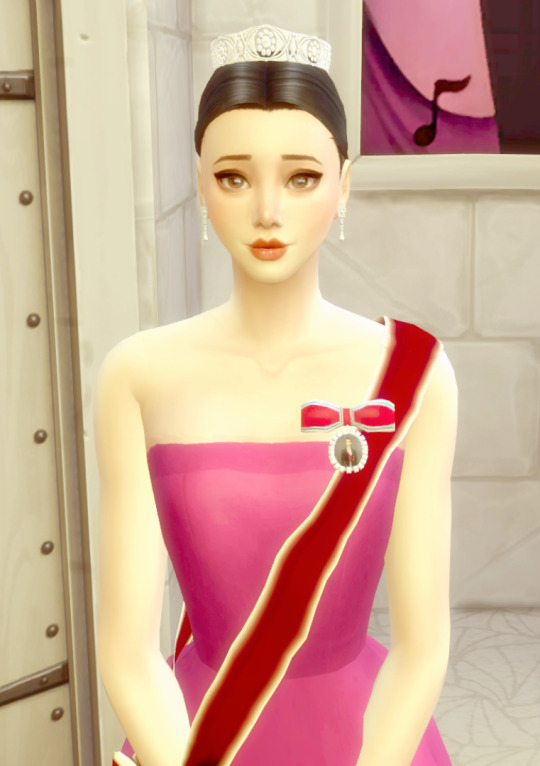
Crown Princess Eun-joo gave us another look at a long-time favorite of royal watchers. Lorne Diamond Bandeau - This tiara was personally commissioned by the King of Windenburg in the first state visit to Mt. Komobrei in 1939. Queen Seo-ah then wore it to the state dinner during the visit. Though worn a few times, it hadn’t been seen for a while, finally re-appearing in 2020 when Crown Princess Eun-joo attended a royal ball hosted by the Palace. Known for more simpler taste overall, the tiara perfectly fit in with the others owned by the royal family. It's been a tiara had has often been worn by the members the Mt. Komobrei royal family. Most recently, Princess Joo-eun at a charity gala earlier this year.

Our now Queen Noelle wore wonderful pieces over the day the of her coronation. Which means, we the lovers of the royal pieces have a few things to talk about. Over the coronation day, we got to witness Noelle wearing a few crowns. First up, for her coronation she wore the Saint Amelia's Crown. The crowned, named after the province it was created in depicts the imagery of a sword. It had been gifted to the royal family shortly after the country was created. Despite it's history in the royal family and being shown at certain palace's it's never been wore. Today, Noelle is the first to wear the crown for her coronation! After seeing it photos, it's been amazing to see the real thing!
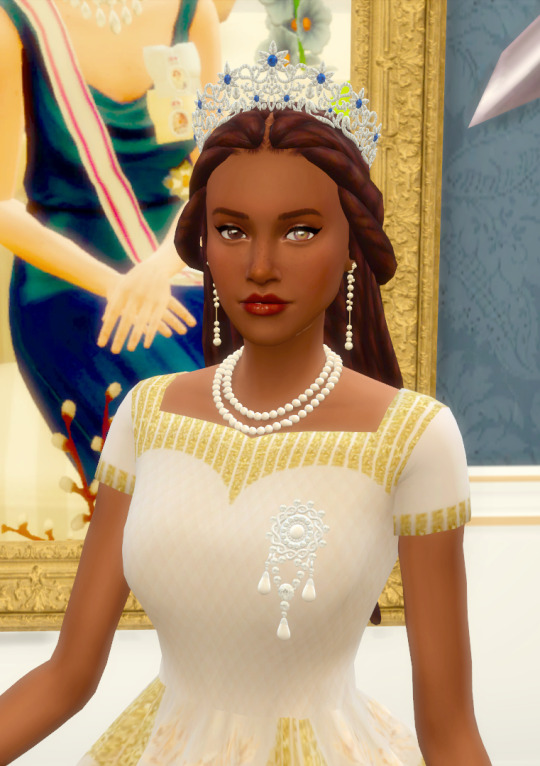
While not in person, we also got to see Queen Noelle in another crown. Shortly after the coronation, photos of the royals and nobility had been released! Pictured with the Saint Amelia's Crown, Queen Noelle was seen wearing the Heaven’s Beacon Tiara. The diamond and sapphire tiara was commissioned by King Charles for his wife. It has been a favorite for Queen Roa to wear at state events and we're glad to see Noelle continuing the tradition!
And here you at all! Remember to always follow us for your tiara needs! We have the latest information and are always keeping our eyes open for next tiara finds!
2 notes
·
View notes
Text
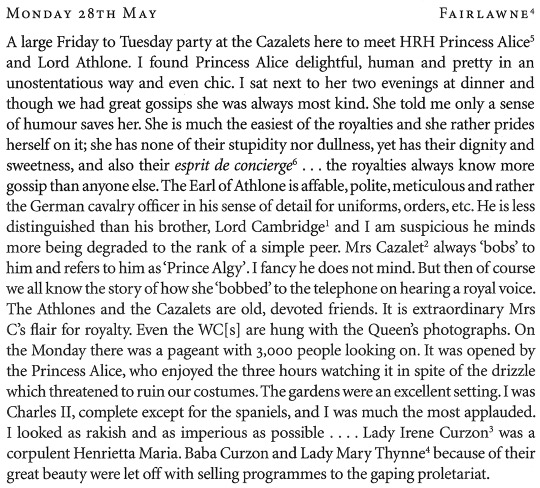
Henry ‘Chips’ Channon: The Diaries (Vol. 1), 1918-38, entry for 28th May 1923
—
Monday 28th May — Fairlawne¹
A large Friday to Tuesday party at the Cazalets here to meet HRH Princess Alice² and Lord Athlone. I found Princess Alice delightful, human and pretty in an unostentatious way and even chic. I sat next to her two evenings at dinner and though we had great gossips she was always most kind. She told me only a sense of humour saves her. She is much the easiest of royalties and she rather prides herself on it; she has none of the stupidity nor dullness, yet has their dignity sweetness, and also their esprit de concierge³ . . . the royalties always know more gossip than anyone else. The Earl of Athlone is affable, polite, meticulous and rather and the German cavalry officer in his sense of detail for uniforms, orders, etc. He is less distinguished than his brother, Lord Cambridge⁴ and I am suspicious he minds more being degraded to the rank of a simple per. Mrs Cazalet⁵ always ‘bobs’ to him and refers to him as ‘Prince Algy’. I fancy he does not mind. But then of course we all know the story of how she ‘bobbed’ to the telephone on hearing a royal voice. The Athlones and the Cazalets are old, devoted friends. It is extraordinary Mrs C’s flair for royalty. Even the WC[s] are hung with the Queen’s photographs. On the Monday there was a pageant with 3,000 people looking on. It was opened by the Princess Alice, who enjoyed the three hours watching it in spite of the drizzle which threatened to ruin our costumes. The gardens were an excellent setting. I was Charles II, complete except for the spaniels, and I was much the most applauded. I looked as rakish and as imperious as possible . . . . Lady Irene Curzon⁶ was a corpulent Henrietta Maria. Baba Curzon and Lady Mary Thynne⁷ because of their great beauty were let off with selling programmes to the gaping proletariat.
—
1. An estate in west Kent, near Tonbridge, owned by the Cazalet family from 1880.
2. Princess Alice Mary Victoria Augusta Pauline (1883-1981), daughter of Prince Leopold, Duke of Albany, youngest son of Queen Victoria; she was therefore the King’s cousin. She married in 1904 Prince Alexander of Teck (1874-1957), brother of the future Queen Mary; his title was anglicised in 1917 after the creation of the House of Windsor and he was granted the earldom of Athlone, after which his wife was known as Princess Alice, Countess of Athlone.
3. The spirit of a concierge; collecting gossip about all who pass through.
4. Adolphus Charles Alexander Albert Edward George Philip Louis Ladislaus, Duke of Teck (1868-1927). Like his brother, he relinquished his German titles in 1917 and, as brother of the Queen Consort, was created 1st Marquess of Cambridge. His younger brother was one rank below him in the peerage.
5. Maud Lucia Heron-Maxwell (1868-1952), married in 1893 William Marshall Cazalet (1865-1932); she was the mother of Victor Cazalet.
6. Mary Irene Curzon (1896-1966), known as Lady Irene Curzon after her father’s advancement to an earldom in 1911, was Lord Curzon’s eldest daughter. On his death in 1925 she inherited the barony of Ravensdale, and in 1958 was enabled to sit in the House of Lords by being granted a life peerage. She never married, declining a proposal from Victor Cazalet.
7. Lady Mary Beatrice Thynne (1903-74), third daughter of the 5th Marquess of Bath; she married in 1927 Charles Wilson (1904-74), 3rd Baron Nunburnholme.
#chips channon#channon diaries#1923#1920s#william cazalet#maud cazalet#alice athlone#alexander athlone#adolphus cambridge#irene ravensdale#baba metcalfe#mary nunburnholme#🕰️
4 notes
·
View notes
Text

Historic 14th century medieval Doune Castle, with a dark, moody, dramatic sky in Perthshire, Scotland.

Sunset over Doune Castle in the Stirling district, Scotland. It is a medieval courtyard fortress built around 1400 by Robert Stewart, Duke of Albany, Regent of Scotland.
History of Doune Castle Robert Stewart, who ruled Scotland from 1388 until his death in 1420, held the titles of Earl of Menteith and Fife through marriage to Margaret, Countess of Menteith and reigned in place of his incapacitated brother Robert III of Scotland. < When he died, his eldest son Murdoch took over the reign, shortly after James I regained power in 1424 after his release from English captivity.
This royal castle later became a hunting lodge and a place of retreat for various monarchs for more than a century. Ownership of the castle passed to Sir James Stewart, the first Lord Doune, in 1570. The title of Earl of Moray was then acquired by the occupants of the castle by marriage. Doune Castle has since been owned by the Earls of Moray. Restoration work was carried out in 1883 and 1970, and in 1984 the 20th Earl of Moray entrusted the castle to the nation. It is now in the care of historic Scottish monuments, Historic Environment Scotland (but not mentioned in these 24 reasons to visit Scotland).
see more :
0 notes
Text
This day in history, January 29, 1824 A. D., 199 years ago, Louisa Maria Caroline , countess of Albany, died at Florence, ... #history #thisdayinhistory #chronology #historical #events
The following excerpt was not changed from its original text to maintain literary integrity; therefore, some expressions may be archaic.JANUARY 29. 1824. Louisa Maria Caroline, countess of Albany, died at Florence, aged 72. She was the daughter of a German prince, and married Charles Stuart, the English pretender, whence she derived the title of countess of Albany. They resided at Rome, and had a…
View On WordPress
0 notes
Text
January 03

[1892] J.R.R. Tolkien, British author, born in Bloemfontein, South Africa.
[1939] Nikos Alefantos, Greek football midfielder and manager (Olympiacos), born in Edessa, Greece.
[1940] Bernard Blaut, Polish football midfielder and manager (UAE), born in Krapkowice, Poland.
[1946] Michalis Kritikopoulos, Greek football striker, born in Kaisariani, Greece.
[1952] Jim Ross, American pro wrestling announcer (WWE), born in Fort Bragg, California.
[1953] Peter Taylor, English football winger and manager (Leicester City, Hull, Crystal Palace), born in Rochford, England.
[1956] Mel Gibson, American actor and filmmaker, born in Perkskill, New York.
[1976] Angelos Basinas, Greek football defensive midfielder, born in Chalkida, Greece.
[1977] Lee Bowyer, English football midfielder and manager (Charlton Athletic), born in London, England.
[1986] Jacob Timpano, Australian football player.
[1988] Ikechi Anya, Scottish football midfielder, born in Glasgow, Scotland.
[1988] Jonny Evans, Northern Irish football defender, born in Belfast, Northern Ireland.
[1990] Yoichiro Kakitani, Japanese football midfielder, born in Osaka, Japan.
[2003] Greta Thunberg, Swedish climate change activist, born in Stockholm, Sweden.

[1322] Philip V, King of France (from 1316) and king of Navarre (as Philip II, from 1314). died.
[1437] Catherine of Valois, French Princess, wife of King Henry V of England, mother of King Henry VI, grandmother of the first Tudor monarch of England, King Henry VII, died.
[1701] Prince Louis I of Monaco, died.
[1705] Luca Giordano, Italian painter, died.
[1979] Conrad Hilton, American hotel mogul, dies at 91.
[1981] Princess Alice of Albany, Countess of Athlone, last surviving grandchild of Queen Victoria, dies at 97.
[2022] Kamel Lemoui, Algerian football defender and manager (Algeria), dies from COVID-19 at 82.
#on this day in history#on this day#otdih#otd#birthdays#rest in peace#j r r tolkien#jrr tolkien#jim ross#greta thunberg#princess alice#conrad hilton#catherine of valois#luca giordano#mel gibson#january#january 03
1 note
·
View note
Text


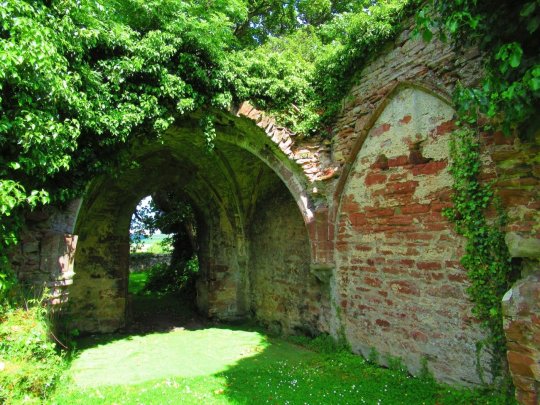
David Stewart, 1st Duke of Rothesay and heir to the throne of Scotland died on March 26th 1402.
In all the long history of the Stewart dynasty there are many tragic figures such as Mary, Queen of Scots and King Charles I, but surely there can be no more hapless and lamentable bearer of the name than the first prince to ever carry the title of the Duke of Rothesay.
David Stewart was the heir to the throne of Scotland at the end of the 14th century until he lost his claim to kingship, and his life, at the behest of his own uncle. His death occurred in the strangest of circumstances in this week of 1402.
t was a time of great jostling for power within the Stewart clan and their fellow Scottish aristocrats. David was born on or around October 24th, 1378, as the son of John, Earl of Carrick, the heir to the Scottish throne, and his wife Countess Anabella nee Drummond. On becoming King he took the name Robert as John and it’s association with the Balliol's’ was considered unlucky, the third to use the name.
Robert III had been kicked by a horse two years before his coronation and as well as physical injury he suffered from melancholia, or depression as we know it.
His younger brother, confusingly also called Robert, was the Earl of Fife who had assumed the Lieutenancy and taken control of the governance of Scotland in the early part of Robert III’s reign.
Both Fife and 19-year-old David Stewart were created Dukes, the first in Scotland, in 1398 after David was knighted at the Great Tournament of Edinburgh arranged by his mother. Fife became Duke of Albany and David became Duke of Rothesay, the title which has passed down to the heirs to the Scottish throne – Prince Charles is the current holder.
Albany’s grip on power had seemed secure at first but as her husband’s health deteriorated, Queen Anabella began to take more control, and she also pushed the cause of her son David as the heir, arranging for him to become the Lieutenant in 1399. The problem was David’s personality – he was a self-indulgent wild child, who grew increasingly debauched as his teens wore on.
He was also arrogant to a fault, and despite being engaged and probably married to Elizabeth Dunbar, daughter of the Earl of March, he decided for dynastic reasons to marry Mary Douglas, daughter of the hugely powerful 3rd earl of Douglas, known as Archibald the Grim.
The Earl of March was furious and switched allegiance to King Henry IV of England who promptly invaded Scotland but had to go home when Edinburgh Castle thwarted his siege. Poor David got the blame for the invasion and his already sagging popularity hit a new low.
When both Archibald the Grim and his mother died in 1401, the Duke of Rothesay was in a very vulnerable position as his uncle Albany moved to complete his control of the kingdom. Albany was assisted in this by Archibald, 4th Earl of Douglas who greatly disliked Rothesay.
Early in 1402, Albany moved to consolidate his power by conspiring with Archibald Douglas to have his nephew David arrested and imprisoned in Albany’s Falkland Palace in Fife on trumped up charges.
It was there that David died on March 26, 1402, most probably from starvation. Whether he was murdered or not is unknown. The official verdict was that Rothesay died of natural causes but the circumstances said otherwise.
His father, the virtually insane King Robert III, presided over a council of enquiry and had to put his name to a document which exonerated Albany and Douglas.
The King wrote: “We consider as excused the aforementioned Robert and Archibald, and anyone who took part in this affair with them, that is any who arrested, detained, guarded, gave them advice, and all others who gave them counsel, help or support, or executed their order or command in any way whatsoever, and in our said council we openly and publicly declared, pronounced and determined definitively and by the tenor of this our present document declare, pronounce, and by this definitive sentence judge them and each of them to be innocent, harmless, blameless, quit, free and immune completely in all respects.”
Robert even ordered the end to malignant rumours: “Wherefore we strictly order and command all and singular our subjects, of whatever standing or condition they be, that they do not slander the said Robert and Archibald and their participants, accomplices or adherents in this deed, as aforesaid, by word or action, nor murmur against them in any way whereby their good reputation is hurt or any prejudice is generated, under all penalty which may be applicable hereafter in any way by law.”
The opposition silenced, Albany was in complete control and remained so even after Robert III died in 1406, when David Stewart’s younger brother James became King. But having fled from the marauding Douglases, young James was at that time in the custody of the English court and would remain an exile for 18 years.
How much pressure was put on the King at this time is not known, however as insane as he was, he decided to send his other son, Prince James, aged only about 1, to France for safety. As you know from last Tuesday’s post, his ship was boarded by pirates and he ended up as a “guest” of the English, for the best part of 20 years.
When Robert III heard of his son's capture, he became even more depressed. He refused any food and died within a few days on April 4th, 1406.
Robert asked to be buried under a dunghill with the epitaph: Here lies the worst of Kings and the most miserable of men as he did not consider himself worthy of the honour. He ended up being buried in Paisley Abbey.
David Duke of Rothesay is said to have been buried at Lindores a Tironensian abbey on the outskirts of Newburgh in Fife, which never survived the vandalism of the Scottish Reformation.
Pics are Falkland Palace, then and now, and Lindores Abbey ruins.
21 notes
·
View notes